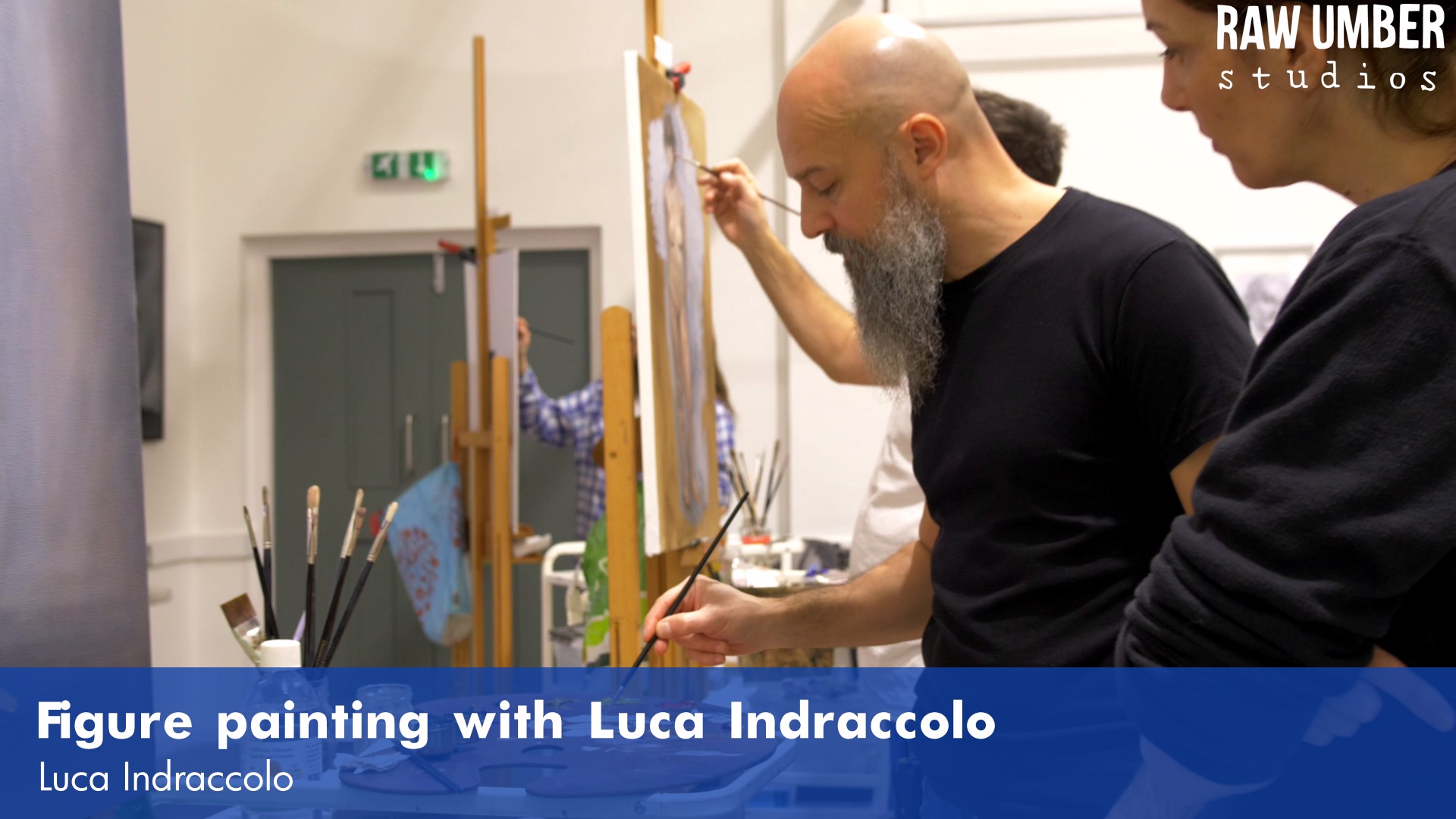Luca Indraccolo - Artist Spotlight
Monday 25 April, 2022
Luca Indraccolo, a leading painter of the human form, regularly teaches workshops at our studio in Stroud. He told Raw Umber Studios the story of how he embarked on his career in art.
It’s Naples - the late 70s - and Luca Indraccolo’s cousins are out in the street, playing football under a scorching sun.
Not Luca.
Instead, the young boy is inside, sitting on his grandfather’s lap, watching as the elderly man paints the landscapes he loves. His grandfather is permanently silent: surgery to remove a tumour has left him unable to speak. But boy and man understand the language of art together.
'I just loved being with him,’ Luca recalls. ‘It always made my day when my grandfather would give me an old brush. That’s the earliest I can remember being drawn to painting.’
Luca’s reaction to art had always been instinctive. As a very young child, he marvelled at his first Caravaggio, blown away that the artist had painted the very dirt under the fingernails of his figures.
And then there was a moment in kindergarten. The children had been set an activity, to create a figurine in clay. Luca made a kangaroo. At the time, he didn’t understand why; but his teacher called a friend from the prestigious Capodimonte ceramics school. ‘They took me into a corridor, where they had set up a little table for the two of us. And he taught me how to sculpt roses. I remember to this day how to do them.’
'For my mum, the idea of me wanting to pursue a career in art was terrifying.’
So a career in art was a no-brainer?
Luca laughs. ‘There’s this whole idea that an artist won’t be able to support himself. And my mum certainly thought that. Her family had had bakeries in Naples when she was little. However, because of my grandfather’s illness, he had mismanaged the business and lost it all. So, for my mum, the idea of me wanting to pursue a career in art was terrifying.’
Graphic design was the compromise. And not an onerous one, either. Luca enjoyed the idea of commercial art – ‘To this day, I still love doing a little’ – and he was good at it. His work took him all over the world: living in Germany, England, the United States; the peak was being appointed a creative director for Saatchi & Saatchi.
‘The problem was, making a career in advertising means you end up designing less and less. It was a bad time, the last couple of years. I wasn’t creating; I was just managing people. That was when I decided this wasn’t doing it for me.’
Surely that must have been terrifying? Giving up such a prestigious job for the unknown.
‘It was very scary! But, if I’m not happy, I need to change things. I didn’t have commitments, and I thought, ‘YOLO’.’
And now?
‘When people ask me if I miss it, my usual reply is, ‘I miss the salary!’’
His training – some done in tandem with his erstwhile career – has been intense. Luca’s focus on the human figure led him to study anatomy with an illustrator: the scaffolding of the body; the bone structure; learning the landmarks of the body, from cheekbone to breastbone to kneecap. Understanding how muscles influence form. How those muscles function, so movement can transfer to canvas.
‘With most subjects, from still lifes to landscapes, you can invent; you can move things; it doesn’t matter.
'If you don’t understand how a knee works, or what makes it appear right, people will notice'
‘But, if you don’t understand how a knee works, or what makes it appear right, people will notice. They might not be able to tell you what’s wrong with it, but we are all familiar with the human form. They will know that something is wrong.’
Leonardo and Michelangelo went so far as to dissect corpses in their thirst to acquire knowledge. ‘I didn’t quite go that far myself, but I was studying at the Florence Academy, and there is a museum there called La Specola [part of the Museum of Natural History]. They have anatomical sculptures in wax; I found that fascinating and went every weekend to sketch.'
He also (‘which might sound a bit gruesome’) watched operations on television, marvelling at how a body-part can be mechanical, yet alive and able to repair itself.
Does that understanding alter his relationship with the figures he draws?
‘It does - but I guess you could say that with any profession. Take architecture: to design something, you also need to understand how the space will be used; the functionality, materials, engineering. It takes a bit of the magic away, this kind of knowledge; but it is also what makes it interesting.’
Today, Luca Indraccolo is a full-time artist, commissioned to paint portraits – he is considered one of the great contemporary masters of portrait painting – as well as creating his own series of compositions.
‘My absolute favourite thing to do is to work on an idea based on experience'
‘My absolute favourite thing to do is to work on an idea based on experience; something I’ve read or seen in a film. I have sketchbooks - like a comedian might have a pad of paper next to a bed and maybe jot down a punch-line in the middle of the night. I make a note – sometimes written down; sometimes a clear image; sometimes it’s a terrible image! Essentially, it’s a way to pin down ideas.’
One painting, for example, comes from a childhood memory of seeing a man in a dodgy part of Naples, with large notes pinned to his jacket. (Luca later understood him to be part of an illegal gambling enterprise.) Another is of ‘lucky’ bronze skulls outside a church in the old city, a passer-by incongruously walking his dog past them.
‘Whenever I want to come up with a new body of work, I’ll go through my books. I discard most ideas, but some I explore and widen. One I’m working on right now is about tuna fishing, especially the bluefin, which is almost extinct. These compositions involve figures, the sea, fish: all very moody.’
'If you can hold a pen and write, you should be able to paint. It’s essentially a lot of work, a lot of dedication, a lot of repetition of exercises.'
For the past 12 years, he has also taught art. If you can hold a pen and write, you should be able to paint, he maintains. ‘It’s essentially a lot of work, a lot of dedication, a lot of repetition of exercises.
‘At the beginning of my teaching, I had a preconception about who would become a good painter. But I’ve been proven wrong over and over. People I didn’t expect to become good succeeded because they put a lot of work in; because they were super-dedicated.’
So what would Luca define as great art?
It’s a tricky question, he muses.
‘For me, art needs to connect emotionally with people, and not all artwork and all artists connect with everybody. I’ve seen people freeze in front of paintings that didn’t move me at all.
‘In terms of aesthetics, I like chiaroscuro; moody pictures; Caravaggio. But, then, if I see Monet’s Water Lilies, I like to stare at the painting for hours. It’s so not the kind of picture I would like to paint - but it does it for me.
If you could own one painting…
‘There are so many. I can’t choose between Picasso’s Guernica, and the Raft of the Medusa by Géricault.’
‘There are so many. I can’t choose between Picasso’s Guernica, and the Raft of the Medusa by Géricault.’
If you could meet one artist…
‘Mancini, who grew up in Naples in the 19th century. From far away, you have a clear idea what you’re looking at; but, close up, his work is very abstract. I would love to have a chat with him about how on earth he did it.’
‘Mancini, who grew up in Naples in the 19th century. From far away, you have a clear idea what you’re looking at; but, close up, his work is very abstract. I would love to have a chat with him about how on earth he did it.’

